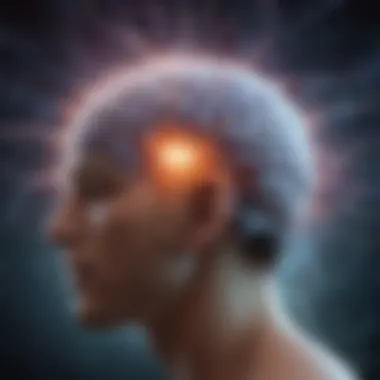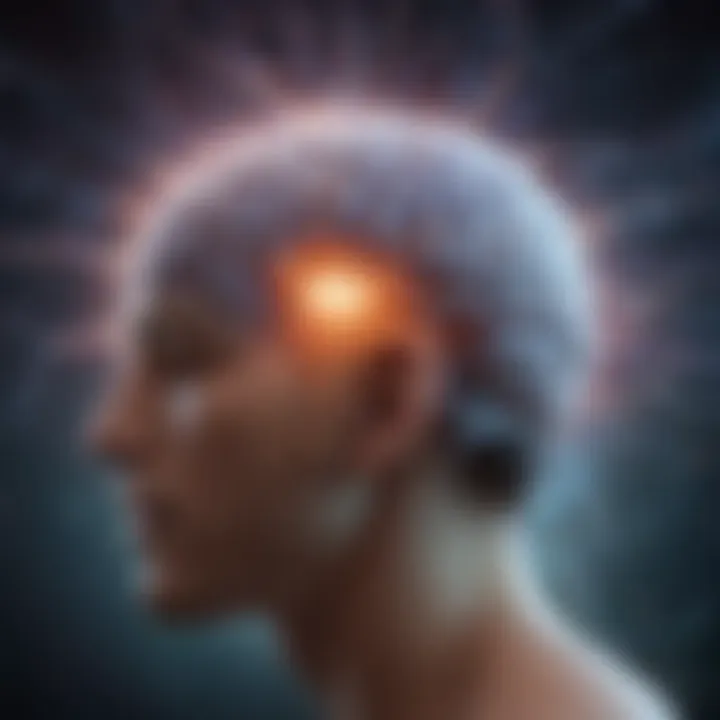Exploring the Dimensions of Lucid Dreaming


Intro
Lucid dreaming, a term that might sound like a whimsical idea, is in fact a rich and complex subject that many people find captivating. When one finds themselves aware that they are dreaming while in the dream itself, that’s lucid dreaming. It's as if the curtain has been drawn back, allowing one to step into a world where they can manipulate their surroundings and engage in fantastical adventures, all while resting in the comfort of their bed.
The origins of this phenomenon trace back to ancient cultures, where it was often seen as a spiritual or mystical experience. Throughout history, various traditions, from Tibetan Buddhism to indigenous tribes, have acknowledged and embraced the practice of lucid dreaming, often attributing it profound significance.
In today's fast-paced world, the allure of lucid dreaming extends beyond mere curiosity. With numerous studies unveiling potential benefits such as enhanced creativity, improved problem-solving skills, and even therapeutic applications, this topic resonates especially well with those looking to dive deeper into their own psyche or harness their subconscious for constructive purposes.
This article is structured to provide readers with a thorough understanding of lucid dreaming, ranging from definitions and historical contexts to practical techniques for inducing lucidity. By the time readers finish, they should feel armed with insights and transformative practices that could enrich their personal and creative journeys.
Understanding Lucid Dreaming
Lucid dreaming is a remarkable phenomenon that grants individuals the ability to become aware of their own dreams while still in the dreaming state. This awareness opens a door to unique experiences that blend the boundaries of reality and imagination. Understanding this intricate concept is essential, as it not only raises our awareness about the nature of consciousness but also highlights potential benefits ranging from personal growth to creative enhancement.
When a person becomes aware they are dreaming, they often harness this opportunity to explore the subconscious mind with unprecedented clarity. This act of recognition leads to an enhanced sense of agency, where the dreamer can manipulate the environment, interact with dream characters, or even engage in thrilling escapades without any real-world consequences. As one might say, it’s akin to holding the keys to your own wonderland, where the limits are dictated solely by one’s imagination.
From a psychological standpoint, lucid dreaming offers a wealth of possibilities. Not only can it contribute to deeper self-understanding, but it can also serve as a valuable tool for individuals facing challenges such as recurring nightmares or anxiety. Being able to confront and reshape these situations in a dream can provide catharsis and foster resilience. In this light, lucid dreaming can play a critical role in enhancing mental well-being.
In addition, this section will delve into the mechanics of how lucid dreaming works, revealing the intricacies of brain activity during these states. By fostering a greater understanding of lucid dreaming, we become better equipped to explore its myriad effects on our mental health and creativity.
Defining Lucid Dreaming
Lucid dreaming can be defined as a state where the dreamer maintains awareness of the dream while still engaged in the dream experience. This awareness often leads to varying degrees of control over the dream narrative. Although the experiences can differ widely among individuals, the common thread remains the recognition that one is dreaming.
The concept can be traced back to various cultures and philosophies, often suggesting a heightened state of consciousness. Some might argue that it forms a bridge between the conscious and subconscious mind, allowing for deeper introspection. Essential terms in this regard include self-awareness and dream control, which significantly distinguish lucid dreamers from those who experience regular dreams without awareness of their dream state.
Importantly, the act of lucid dreaming is not merely a pastime; for many, it’s a tool that invites exploration and self-discovery. pIt can turn into a transformative experience where the dreamer can face fears and pursue aspirations in a safe environment.
Historical Perspectives
The phenomenon of lucidity in dreams is far from modern; it has a rich historical context that spans diverse cultures and epochs. Ancient texts, such as those from the Greeks and Romans, reveal philosophical contemplations surrounding dreams that frequently blur the lines between the real and surreal.
In various indigenous cultures, dreams were often considered portals to alternate realities or realms inhabited by spirits. The practice of dreamtime among Aboriginal Australians is a profound example, where dreams serve as a means to connect with ancestors and the spiritual world. This deep-seated belief emphasizes that dreams held valuable insights into one’s life journeys and societal roles.
Fast forward to contemporary times, lucid dreaming gained prominent recognition in the West during the late 19th and early 20th centuries, thanks in part to the work of pioneers like Sigmund Freud and Carl Jung. Freud’s exploration of the unconscious and Jung’s interpretation of dreams laid the groundwork for understanding the psychological implications of dreaming.
Lucid dreaming, with its roots deeply embedded in history, challenges our perception of reality and invites exploration that transcends the ordinary.
In summary, this historical backdrop reflects humanity’s ongoing fascination with dreams, nudging us to consider the possibilities that lucid dreaming holds, not only for personal gain but also for a broader understanding of our psyche.
The Science Behind Lucid Dreaming
Understanding the scientific underpinnings of lucid dreaming provides insight into how we have the capacity to navigate within our dreams with awareness. This section emphasizes the importance of brain function and physiological responses associated with lucid dreaming. Recognizing these aspects not only contributes to our grasp of the phenomenon but also opens up avenues for personal applications and therapeutic benefits. This truly multifaceted approach to understanding lucid dreaming enriches the overall narrative.
Brain Activity During Lucid Dreams
Neuroimaging Studies
Neuroimaging studies have shed light on the brain activity occurring when individuals are conscious within their dreams. These studies primarily utilize functional MRI (fMRI) and EEG technology to capture real-time brain functions. Notably, researchers have observed heightened activity in the prefrontal cortex during lucid episodes, an area often linked to self-awareness and critical thinking.
The key characteristic of neuroimaging studies is their ability to provide tangible evidence that supports subjective experiences of lucidity. Many who investigate lucid dreaming are drawn to these studies because they blend subjective and objective insights.
One unique feature of neuroimaging studies is their capability to visualize brain responses and identify specific regions that become active during lucidity. This is beneficial because it lends scientific credibility to what was once considered mere anecdotal evidence. However, the disadvantage is that such studies can be costly and require cooperative participants, limiting the scope of research.


Sleep Stages
In exploring sleep stages, we find that lucid dreams typically occur during REM (Rapid Eye Movement) sleep. This phase is characterized by increased brain activity, vivid dreaming, and muscle atonia. The key characteristic of sleep stages relevant to lucid dreaming is the cycle of sleep architecture, which lays the groundwork for when and how lucidity can arise.
It’s a popular choice for this article to include sleep stages as it underpins our understanding of the dream experience. The intricate dance between different sleep stages plays a crucial role, showing how the body and mind work together to foster creative dream exploration.
The unique feature here is the periodic nature of REM sleep throughout the night. This cycle, which typically recurs every 90 minutes, allows individuals multiple opportunities to experience lucidity. The mixed blessing is that while this multiple exposure is advantageous, awakening from a lucid dream too soon can lead to confusion about what was experienced upon waking.
Physiological Responses
Looking deeper into physiological responses, studies have shown that there are distinct bodily reactions correlated with lucid dreaming. For example, during these dreams, individuals report variations in heart rate and levels of cortisol, a stress hormone. These physiological changes provide a fascinating lens through which one can examine the connection between mind and body during different states of consciousness.
The interrelationship between physiological responses and lucid dreaming demonstrates not just the mind's involvement, but also the body’s active participation in the dreaming process. Enhancing this understanding can lead to improved techniques for lucid dream induction and greater control over dream experiences.
In summary, the science behind lucid dreaming interlaces brain activity, physiological responses, and the intricate nuances of sleep itself. This solid foundation can help individuals harness this unique ability, contributing significantly to both personal creativity and psychological well-being.
"The study of lucid dreaming serves as a bridge between the conscious and subconscious, showcasing the remarkable capacity of the human mind."
Ongoing research in this domain continues to enhance our understanding, prompting further inquiry into potential therapeutic applications, as well as practical techniques for those eager to explore the vast universe that exists within their dreams.
Techniques for Inducing Lucid Dreams
When venturing into the world of lucid dreaming, one cannot ignore the significance of learning different techniques used to induce this state of awareness during sleep. Understanding these methods can greatly impact one's ability to not just enter a lucid dream, but also to manipulate it for personal growth, creativity, or even therapeutic purposes. Knowing various approaches gives dreamers a toolbox from which they can experiment and find what resonates best with their own individual psyche.
Reality Testing
Reality testing is perhaps one of the foundational practices for those seeking lucidity in their dreams. The basic idea is to train your brain to question the nature of reality throughout the day, which may eventually carry over into your dreams. This technique often involves checking your surroundings at random moments to discern whether you are dreaming or awake. There are a few popular methods for reality testing:
- Finger Pinch: Trying to pinch your nose and still breath through it. If you can, it’s likely a dream.
- Clock Check: Looking at a clock or text, looking away, and then looking back. If the time or text changes dramatically, you may be dreaming.
- Reflective Surface: Looking in a mirror. Often, reflections in dreams can appear distorted or nonexistent.
This technique strengthens dream recall and critical thinking, making it easier to spot the oddities of a dream state. While it seems simple enough, it requires consistency and diligence in daily life.
Mnemonic Induction of Lucid Dreams
Mnemonic Induction of Lucid Dreams, or MILD for short, incorporates memory techniques into dream induction. At its core, this technique hinges on the premise of setting intentions before sleep. The process is straightforward but requires clear commitment:
- When you awaken after a dream, recall it in detail. Reflect on signs that could clue you into a dream state.
- As you prepare to go back to sleep, tell yourself, "I will realize I am dreaming".
- Visualize yourself in the dream and becoming lucd, repeating the intention firmly in your mind.
This method not only heightens the likelihood of lucidity but also enhances dream recall. Over time, practitioners may find themselves becoming more adept at recognizing the dream state, which opens doors to deeper exploration and psychological insight.
Wake-Back-to-Bed Technique
The Wake-Back-to-Bed (WBTB) technique is a popular approach amongst advanced lucid dreamers. This method capitalizes on the natural sleep cycle and can lead to a higher chance of entering a lucid state. Here’s how it typically unfolds:
- Initial Sleep: Go to bed and sleep for about 5 to 6 hours.
- Wake Up: Set an alarm to wake you after this period. Do something light and low-stimulation for about 20 to 30 minutes, like reading about lucid dreaming, journaling, or sipping some water.
- Return to Sleep: Go back to bed with the intention of entering a lucid dream.
This technique exploits the natural REM sleep following a period of wakefulness, generally resulting in vivid dreams that can be far more conducive to lucidity. Importantly, it requires some planning and determination, as interrupting one’s sleep cycle can initially be jarring. However, with practice, many find joy in the art of waking, reflecting, and re-entering dreams consciously.
With dedication to these techniques and a willingness to explore the dream realm, the possibilities of lucid dreaming expand greatly.
By integrating these techniques into one's sleep routine, dreamers can not only enhance their likelihood of achieving lucidity but also utilize it as a platform for creative exploration and self-discovery.
Psychological Benefits
The landscape of human consciousness is intricate, and lucid dreaming takes place at its frontier. Exploring the psychological benefits of lucid dreaming provides valuable insights into how harnessing this state of awareness can impact creative thinking and emotional well-being. Understanding these benefits isn't just for dream enthusiasts; it serves as a gateway for those curious about unlocking their full mental potential.


Enhancing Creativity
Lucid dreaming can act as a catalyst for creativity by offering an unrestricted playground for the mind. When one becomes aware that they are dreaming, they can manipulate the dream environment at will, allowing a stream-of-consciousness approach to ideation. Artists, writers, and inventors have reported significant breakthroughs during their dreams, claiming that the lack of limiting beliefs and external constraints allows novel concepts to flow freely.
- A painter might find inspiration from swirling colors and abstract forms not possible in waking life.
- A musician might compose melodies influenced by dream sequences that challenge ordinary patterns.
- Writers can explore fantastical plots or dialogues that are otherwise suppressed by the rational mind.
While grounded in personal accounts, scientific studies support this point. Research indicates that the brain's activity in a lucid state resembles that of being wide awake, which means creative areas are activated. This suggests that entering a lucid dream state may bolster creative processes, benefiting artists and innovators alike.
"In a lucid dream, the barriers dissolve, allowing true creativity to surface." — Anonymous Dreamer
Overcoming Nightmares
On the flip side, lucid dreaming offers a profound way for individuals to confront and overcome nightmares. Nightmares can be distressing, and they often stem from unresolved fears or anxieties. With the ability to realize they are in a dream, individuals can face their phobias directly.
- Instead of running from an ominous figure, the dreamer can confront it and transform the scenario into something harmless, breaking the cycle of fear.
- Participants in studies have noted a reduction in nightmare frequency after learning to induce lucid dreams, showcasing empowerment through awareness.
- Techniques such as visualizing successful outcomes in nightmares can fundamentally reshape the narrative, rewriting harmful scripts ingrained in the subconscious.
Experiencing nightmares is not merely a nuisance; they can also carry emotional weight that spills into waking life. By using lucid dreaming to address these fears, one can reclaim a sense of control, contributing to overall psychological resilience and well-being.
In summary, the psychological benefits of lucid dreaming remind us of the complexities of our mental capacities. From enhancing creativity to combating nightmares, the potential impacts are substantial, paving the way for deeper exploration of one’s psyche. As we traverse through the realms of dreams, the insights gained can illuminate the path for personal growth that extends beyond sleep.
Challenges and Limitations
Lucid dreaming is a fascinating phenomenon that provides a unique glimpse into our subconscious. However, it is important to recognize the challenges and limitations that surround this topic. Understanding these can help individuals navigate their journey into the world of lucid dreaming more effectively. Among these challenges, we find the difficulty in induction and potential psychological risks that may arise.
Difficulty in Induction
Inducing a lucid dream is often easier said than done. Many enthusiasts pour hours of effort into mastering various techniques, yet many still find themselves waking up frustrated and disheartened. This difficulty can stem from several factors:
- Inconsistent Sleep Patterns: Not getting enough quality sleep can significantly hinder one’s ability to enter the REM stages of sleep where lucid dreaming predominantly occurs.
- Lack of Awareness: To achieve lucidity, one must be able to recognize when they are dreaming. If someone doesn't regularly practice reality checks in waking life, they may miss the opportunity to do so during a dream.
- Mental Barriers: Anxiety about achieving lucidity can ironically block the very experiences one hopes to attain. When we overlay our expectations onto the dreaming process, we might inadvertently distill the experience into frustration.
Realistically, not every attempt will yield a successful lucid dream. This unpredictability can serve as a double-edged sword. On one hand, the challenge adds an air of intrigue and excitement, but on the other hand, it can discourage eager practitioners from pursuing it further.
Potential Psychological Risks
While the psychological benefits of lucid dreaming may be celebrated, it's equally important to address the potential risks involved. Neglecting these warnings could lead to adverse effects on both mental health and overall well-being:
- Sleep Disturbances: Some individuals could experience sleep disturbances as a direct result of trying to achieve lucidity. Instead of becoming more rested, one might find themselves tangled in a cycle of insomnia, tossing and turning in pursuit of their dreams.
- Derealization: A small subset of people might experience derealization—a feeling that reality is not real or that one is detached from their surroundings—especially after extensive periods of lucid dreaming.
- Lucid Dreaming Dependency: There’s a risk that individuals may become overly dependent on dreaming as a coping mechanism. While it can be an outlet for creativity or stress relief, relying solely on it may prevent one from engaging with the world around them.
"Lucid dreaming can be a beautiful tool for self-exploration, but like any tool, it must be used with caution and respect."
Cultural Significance
Cultural significance plays a pivotal role in understanding lucid dreaming as it transcends mere psychological implications. Throughout history, dreams have been viewed as conduits to the divine or as portals to the unconscious. Many cultures have engaged in practices that align closely with lucid dreaming, showcasing its influence on spirituality, creativity, and personal insight. By examining these historical contexts, we gain a deeper appreciation for lucid dreaming, highlighting how it has shaped cultural narratives and human experience.
Lucid Dreaming in Ancient Cultures
Lucid dreaming was not always a modern phenomenon. Many ancient cultures recognized the power of dreams, often employing them as tools for guidance and healing. In numerous tribal societies, shamans or spiritual leaders would enter into lucid states to seek visions or connect with ancestors. For instance, the Indigenous Australian culture has long held that dreams are significant for guiding decisions and interpreting the spirit world. These practices were not merely for entertainment; they served practical functions in day-to-day life.
In Tibetan Buddhism, dream yoga is a vital part of meditation practice. Practitioners engage with their dreams purposefully, seeking to maintain awareness during sleep. This technique is believed to enhance spiritual development and facilitate a deeper understanding of the nature of existence. Similarly, the ancient Egyptians viewed dreams as messages from the gods, believing that interpreting them could lead to divine wisdom.
Thus, the cultural roots of lucid dreaming underscore its importance across millennia, showcasing the deep connection between dreamwork and spiritual practices. These insights provide empowering frameworks for many who wish to explore their dreams today.
Modern Interpretations
In contemporary society, the perception of lucid dreaming has shifted. It is increasingly seen through a psychological lens, often incorporated into self-help and wellness paradigms. Practitioners today often emphasize the potential for personal growth and creativity that can stem from achieving lucidity during dreams. This modern interpretation highlights its utility in exploring not only personal desires and fears but also fostering creativity in various fields.


Moreover, advancements in technology and science have paved new avenues for engaging with lucid dreaming. Virtual reality systems and apps designed for dream induction reflect a growing interest in harnessing technology for personal exploration. Online communities like those on Reddit connect enthusiasts globally, sharing experiences and techniques that democratize access to this ancient practice.
The modern view is not devoid of caution, as discussions around potential psychological risks arise. Balancing the allure of self-discovery with the reality of one's mental health remains essential. Still, the potential applications for therapy and self-exploration cannot be overlooked. Lucid dreaming has evolved from esoteric spiritual practice to a topic resonating with a broad audience, pointing to its enduring relevance in human culture.
"Dreaming permits each and every one of us to be quietly and safely insane every night of our lives." – William Dement
In summary, the cultural significance of lucid dreaming is a testament to its rich historical context and its adaptability in today’s world. As we traverse its dimensions, we see how ancient wisdom intertwines with modern practices, allowing individuals to explore their dreams and, in turn, themselves.
Future Research Directions
As the fascination with lucid dreaming continues to grow, the importance of future research directions becomes evident. Delving into this topic can unearth innovative approaches to understanding and inducing lucid dreams. Research not only enhances our knowledge of the phenomenon but also opens up possibilities for practical applications in various fields, including psychology, therapy, and creativity. By pinpointing specific elements such as induction techniques and therapeutic applications, scholars and practitioners can harness the potential benefits of lucid dreaming more effectively.
Innovative Techniques in Induction
While traditional techniques such as reality testing and the Wake-Back-to-Bed method have their merits, emerging technologies offer exciting avenues for enhancing lucidity. The use of devices like EEG headsets can monitor sleep patterns and provide stimuli at the right moment to trigger lucid dreaming.
Moreover, apps designed to deliver auditory cues during REM sleep can encourage users to recognize when they are dreaming. It’s vital to explore user feedback on these tools to refine their effectiveness.
- Wearable Technology: Companies are developing wearable devices that claim to induce lucid dreams. These gadgets often use gentle light cues or vibrations during REM sleep to draw attention to the dream state without waking the sleeper.
- Neuroscientific Research: Investigating how brainwave patterns correspond with lucid dreaming could lead to further breakthroughs in induction techniques. Using transcranial stimulation to facilitate lucidity is also a promising area of study.
Research in this domain could potentially yield a treasure trove of innovative techniques, making lucid dreaming more accessible for many.
Applications in Therapy
The therapeutic potential of lucid dreaming is an area ripe for exploration. Numerous studies suggest that engaging in lucid dreams can empower individuals, providing them with the tools to navigate their subconscious mind. This empowers people to confront fears, such as recurring nightmares, in a safe and controlled environment.
"Lucid dreaming offers a playground for the mind, where the boundaries of reality blur, and creativity can flourish."
- Treating PTSD: Some therapists are looking into how lucid dreaming can help individuals with post-traumatic stress disorder by allowing them to reexamine distressing events within their dreams.
- Enhancing Problem-Solving Skills: By actively controlling dream scenarios, individuals can experiment with solutions to real-life issues, potentially enhancing creativity and problem-solving skills.
- Improving Sleep Hygiene: For those who struggle with insomnia, learning lucid dreaming techniques may lead to better sleep practices by instilling a sense of control over their nightly experiences.
Overall, the applications of lucid dreaming in therapy hold significant promise for personal development and healing. Continued research could highlight best practices and expand the use of lucid dreaming as a therapeutic tool, benefitting numerous individuals.
As we look into these future research directions, it becomes clear that the realm of lucid dreaming is not just a niche area of interest, but a dynamic field with practical implications. The unfolding potential of innovative techniques and therapeutic applications underscores the necessity for ongoing research, which can bridge the gap between dream exploration and tangible benefits.
Resources for Further Exploration
Exploring the depths of lucid dreaming expands vastly beyond individual experience. The realm of lucid dreams is rich with layers, and understanding its nuances requires diverse perspectives, insights, and tools. This is where resources play a crucial role, providing both beginners and seasoned practitioners with knowledge and support.
From books that break down the science and art of lucidity to online communities fostering discussions, these resources represent the collective wisdom of dream explorers. They also offer avenues for personal growth, allowing one to gain insights that can transform one's dreaming landscape into a canvas for creativity and exploration.
Books on Lucid Dreaming
Books serve as gateways into the enchanting world of lucid dreaming. Whether you are a novice or have trodden these pathways before, a curated library can deepen your understanding and practice. Areas common in these texts typically include:
- Techniques and methodologies: Various authors break down methods such as wake-back-to-bed, mnemonic induction, and more.
- Scientific research: Some texts delve into captivating studies that explain brain activity during lucid dreaming.
- Personal narratives: Story-driven accounts reveal first-hand experiences, emotional nuances, and transformations through lucid dreaming.
A couple of notable books worth mentioning are:
- "Lucid Dreaming: A Beginner's Guide to Becoming Conscious in Your Dreams" by Charlie Morley
- "Exploring the World of Lucid Dreaming" by Stephen LaBerge and Howard Rheingold
These books not only present theory but extend an invitation to practice and experiment.
Online Communities and Support
In today's digital age, online communities provide a sense of belonging and shared experience for those navigating the mysteries of lucid dreaming. Engaging with fellow dream enthusiasts fosters a supportive environment where individuals can exchange tips, share experiences, and encourage one another.
Platforms such as Reddit offer dedicated forums to discuss lucid dreaming techniques, while Facebook groups can serve as safe havens for sharing vivid dreams and seeking advice. Some benefits of connecting in these spaces include:
- Networking: Meet like-minded individuals who share your passion and curiosity.
- Immediate feedback: Pose questions and receive prompt answers from the community.
- Resource sharing: Members often share links, articles, and personal strategies that enhance the understanding of lucid dreaming.
Most importantly, the engagement in such conversations can ground your practices and offer new ways to harness the extraordinary power of your dreams.
"Dreams are the touchstones of our characters." - Henry David Thoreau







